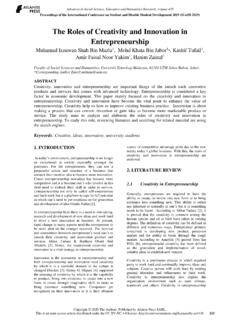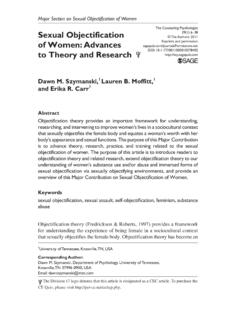Transcription of Technology and Its Use in Education: Present Roles and ...
1 Technology and its use in education : Present Roles and future prospects 1 Technology and its use in education : Present Roles and future prospects Keith Courville Paper Presented at the 2011 Recovery School District Technology Summit thth(June 6 -8 2011, Baton Rouge, Louisiana) Session Name: Current Trends and Recommendations in Technology Technology and its use in education : Present Roles and future prospects 2 Abstract: (Purpose) This article describes two current trends in Educational Technology : distributed learning and electronic databases. (Findings) Topics addressed in this paper include: (1) distributed learning as a means of professional development; (2) distributed learning for content visualization; (3) usage of distributed learning for educational purposes within other fields; (4) electronic databases and their effect on education ; (5) emergence of blended learning and knowledge management as educational fields; (6) issues in the implementation of educational Technology ; (7) future trends in distributed learning and electronic databases; (8) classroom applications of each Technology .
2 (9) future recommendations for the use of distributed learning and electronic databases. (Conclusions) Further development and use of educational Technology for both teachers and students should be pursued as a worthwhile investment for educational achievement. Technology and its use in education : Present Roles and future prospects 3 The Role of Technology in education The role of Technology , in a traditional school setting, is to facilitate, through increased efficiency and effectiveness, the education of knowledge and skills. In order to fully examine this thesis, we must first define several terms.
3 Efficiency will be defined as the quickness by which we obtain knowledge, while the term effectiveness is associated with the amount of imparted knowledge that is operationally mastered. When Technology is directly applied to an educational setting, such as a school, both the students and teachers can be viewed as learners. Thus, we can operate under the assumption that any increase in teacher knowledge and utilization has the impact of increased learning in students. Ultimately, Technology should serve to increase student achievement in schools. Technology can aid in educational achievement through two primary methods: the removal of physical barriers to learning and the transition of focus from the retention of knowledge to its utilization.
4 Each of these methods must be examined in the context of their relation to both the student and the instructor in order to see their value and effect in educational settings. The removal of physical barriers has allowed teachers greater accessibility in regards to professional development and graduate education . Before the age of the internet and the advent of distance learning, engaging in a learning community, such as a workplace network or a school, required a close degree of physical proximity amongst community members. Presently, there are multiple examples of the use of distributed learning Technology in the educational field.
5 First, many graduate schools have begun transitioning into programs that allow for distance education . No longer is it a necessity that teachers have geographical proximity to a university in Technology and its use in education : Present Roles and future prospects 4 order to pursue higher education and certification. This trend towards online classes and educational opportunities has even become so prevalent that there are universities which consist of only online classes, allowing a teacher to complete an entire course of study through distance learning (Dempsey & Van Eck, 2007).
6 Second, the use of distance learning is not limited to the university setting, but also found in school site, district, and state levels of professional development for teachers, with the emergence of web-based conferences and seminars. In addition, internet based Technology allows for teachers to form their own learning communities that are not confined to the local school site. For example, science teachers may use a wiki or content delivery system to network and share information with teachers at other schools both within and beyond their local school district.
7 Even more exciting, is the premise that teachers can not only receive information and training from a central authority, such as district or state personnel, but that teachers may develop content and share their information amongst their peers. This leads to situations of reciprocal teaching and mentorship that are part of a larger informal learning community. In terms of design, online learning communities allow for a multitude discussions and socialization that adhere to a constructivist learning principle, in which people effectively learn information when experiencing and defining knowledge through social contexts (Dempsey & Van Eck, 2007).
8 Students also benefit from the removal of physical barriers through distance learning Technology . In contrast with their teachers, who are focused on professional development related to their job performance, students are often learning new content and that content is often removed from their daily lives. This separation between the content being disseminated and the students' daily interactions and prior knowledge is even more prevalent in lower grade levels. For Technology and its use in education : Present Roles and future prospects 5 example, students may learn the math necessary to balance a budget, before they even get their own checking account or have a checkbook.
9 However, Technology can assist students in the visualization of previously unfamiliar content in a manner which assists in learning. For example, multimedia presentations, which utilize multiple formats of media, such as images, narration, and text, can be used to assist students in concept visualization. Other formats, such as simulations and games can add an extra level of interactivity between the student and the content, which turns the educational process from a passive to an active process. Proponents of multimedia adhere to a cognitive learning philosophy and view the primary advantage to multimedia learning as the usage of multiple learning channels, under the assumption that any one sensory channel can only process a limited amount of information at once (Driscoll, 2007).
10 Even more beneficial is the use of educational Technology , in particular multimedia and simulations, to remove physical barriers such as location and financial limitations. For example, students can view images, which may even consist of videos, of distant landmarks and geographical locations, in lieu of physically traveling to the site. While it may be unfeasible to arrange a field trip for even a few students, all students with access to the internet can use three dimensional and geographic programs to figuratively walk through a distant area. The cost of this aforementioned geographical Technology is one of its great advantages, as this Technology can be readily accessed for no cost through Technology provided by the corporation Google and their web based map tools.













